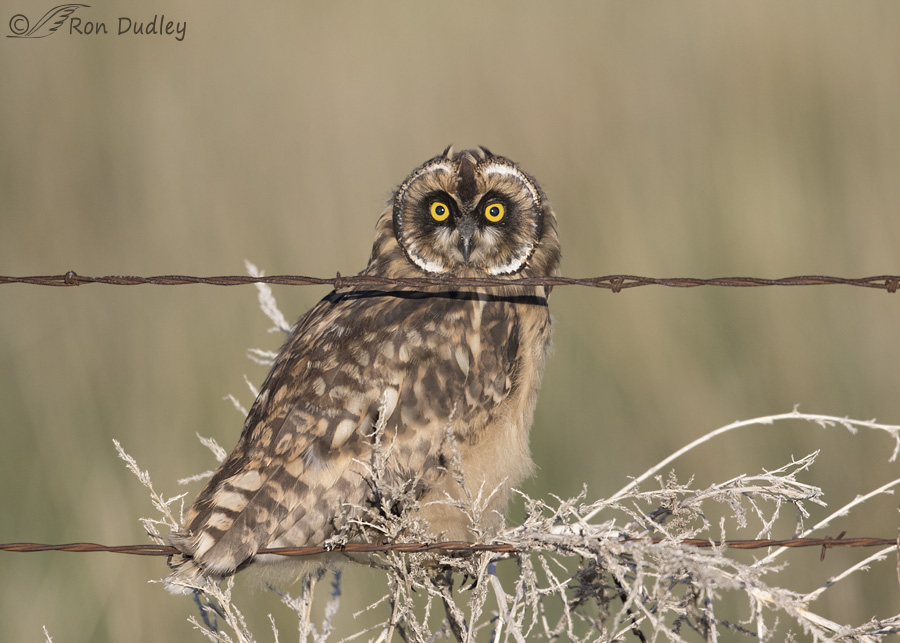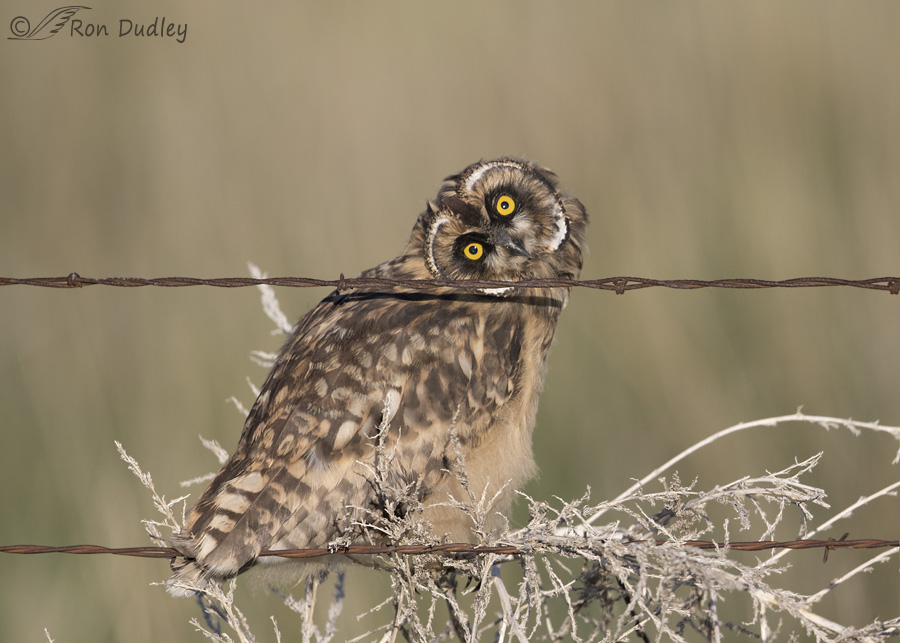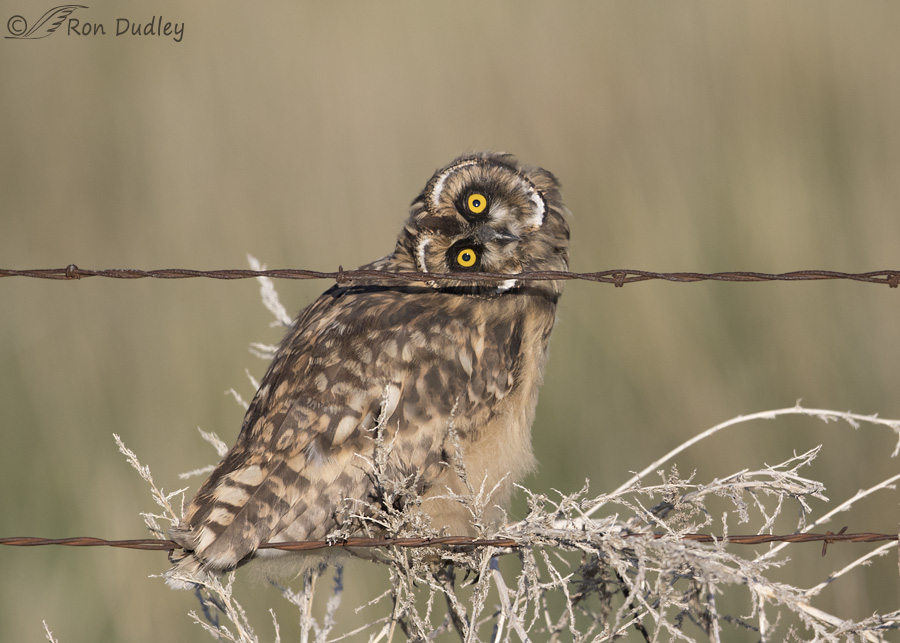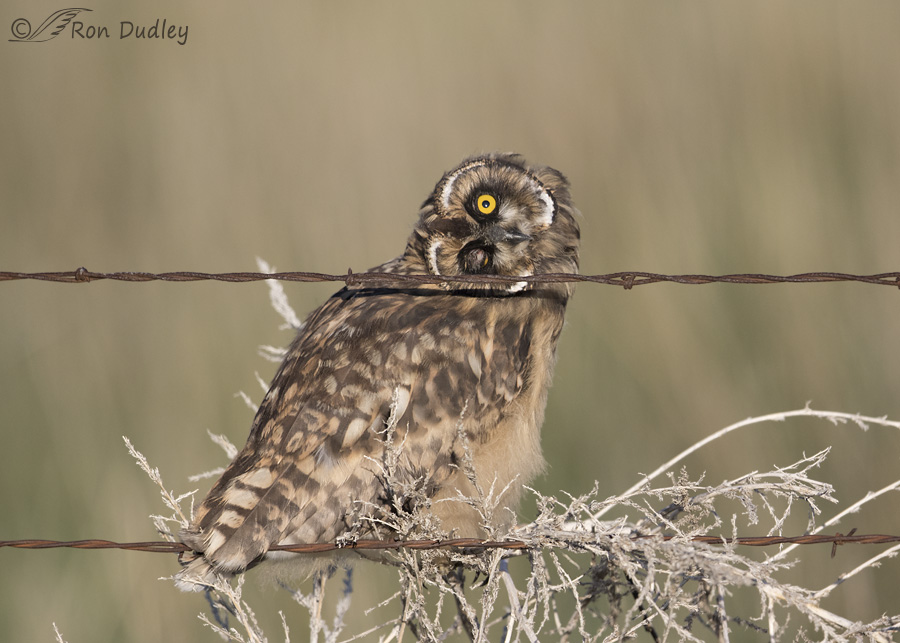It’s often a fool’s errand to assign motivation to unexplained bird behaviors so in this case I won’t make any claims. But I have to wonder if this young owl might have been experimenting with its eyesight.
I don’t know the sex of this bird but for the sake of convenience I’ll refer to it as a male in this post.
1/5000, f/6.3, ISO 500, Canon 7D Mark II, Canon EF 500mm f/4L IS II USM, not baited, set up or called in
With my track record with finding owls entangled in barbed wire I’m always apprehensive when I find one this close to the “devil wire” but this one, photographed last summer in northern Utah, had no problem with it. In fact it may have used the wire as a learning tool.
Here the recently fledged young owl is checking out my pickup with great interest. Notice that he’s holding his ear tufts erect so they’re easily seen. With this species the tufts are short (thus the name “short-eared”) and usually flattened against the head so they’re difficult to see.
1/5000, f/6.3, ISO 500, Canon 7D Mark II, Canon EF 500mm f/4L IS II USM, not baited, set up or called in
Then, as young owls often do, he decided to use parallax on my pickup (with two clicking photographers inside) so he began to rotate his head counterclockwise. He’d already rotated it clockwise just prior to these shots.
Owls use motion parallax in combination with their forward-facing eyes and excellent binocular vision to determine depth in their field of view and young owls in particular are known for practicing the skill regularly. Humans (including me) often find the behavior comical and that contributes to why we find owls so endearing.
1/5000, f/6.3, ISO 500, Canon 7D Mark II, Canon EF 500mm f/4L IS II USM, not baited, set up or called in
But when he reached this degree of rotation the upper wire blocked much of my pickup from the view of his right eye so he…
1/5000, f/6.3, ISO 500, Canon 7D Mark II, Canon EF 500mm f/4L IS II USM, not baited, set up or called in
closed that eye for a few moments by lowering his upper eyelid. Shortly after this shot was taken he rotated his head back to a normal position.
I can’t help wondering why he closed the eye. Owls often blink with their upper eyelid but the timing of this closing of only the right eye, just as that eye’s vision became blocked by the wire, suggests to me that perhaps the young owl was temporarily confused by the sudden loss of visual cues in that eye from my pickup. So he briefly closed it to block the confusing cues to see what would happen.
Was this experimentation and learning – similar to something a human child might do as it tries to interpret a confusing new world or was it only a coincidentally timed blink? I don’t know of course but my money’s on the former.
Ron
Notes on eyelids in owls: Owls have 3 eyelids including “normal” upper and lower lids. Their upper eyelids close when they blink and the lower one closes when they’re sleeping. Their third eyelid, the nictitating membrane or nictitans, is a thin layer of semi-transparent tissue that closed diagonally across the eye from inside to outside. That membrane cleans and lubricates the eye and is also used to protect it in certain situations.
Late Addendum: Friend and blog follower Tana Peery Hunter, a volunteer for Hawkwatch International, helps to care for Galileo the Short-eared Owl that Mia and I rescued from barbed wire last summer. Tana posted a recent cell phone photo of Galileo to Facebook that shows all three if his eyelids and I think it’s cute as hell. Here’s the link to the photo for those who are on FB. I hope it works.






What great shots Ron!
charlotte
Very interesting observation Ron.
I had always thought the head tilting was for sound, to locate a noise source with their offset ears by head tilting. Here is a that discusses the head tilt and sound. Although this video shows more a head bobbing, versus a head rotation.
The fact that you captured the intentional closed eye when it was blocked by the barbed wire seems to indicate that the SEOW was relying on sight also in checking your truck out. I do not see why they would not use both sight and sound.
I have seen experiments with BAOWs where they tested their ability to find prey in completely dark environments, so we know that some owl species can hunt relying solely on sound.
Now you have perked my curiosity on owls use of sight and sound. Thanks
Ed, I always thought they use parallax for both sight and sound. Now I’ll be doing some more research too…
sorry for my mixup of the html tag…
Late to the party, Ron, but what a wonderful, informative post. The link to Galileo was just an added bonus! Great to see him thriving after his scary entanglement in the devil wire. Thanks again!
Diane, I’m glad I added that Galileo link even if at this late point you may be among the few who will see it. Thank you.
Don’t tell anyone, but I’m a fool for the upside-down head thing or any variation thereof! My heart instantly melts when they do that and it makes me giggle.
The other heart-melting behavior for me is that whole thing when their body is moving from hither to yon and their heads remain in one place when they lock their vision onto something interesting. Their heads are seemingly nailed in space as they defy all rules of physics and gravity. While all raptors can do that (I think) with their seven extra vertebra, it’s particularly obvious with Kestrels. So who’s surprised that I go through that giggly exercise as frequently as possible with Skye, the Evil Princess (female American Kestrel)?
This is a wonderful Earth full of all sorts of magics!
It surely is, Laura.
Ron,
My vote is with Patty. The owl is hitting on you.
Stephen Clayson
Then it must not be able to see very well, Stephen…
Ron, I like your theory and love the photos! Nice work! Thank you!
Thanks, Den.
A wonderful series of what has become one of my favorite owls, thanks to you and Mia…I think it’s a female who thinks you’re pretty cute and is giving you a come hither wink….Not too crazy about her nearness to that effing Devil’s wire….
Sorry about duplicates…first didn’t show up at first….
No worries, Patty. Duplicates happen…
I’m reminded of the scene in Apollo 13 where Tom Hanks “covers the moon” with his thumb. Either that, if the little guy was winking at you and Mia.
To me, behavioral adaptations are even more fascinating than physical ones.
“To me, behavioral adaptations are even more fascinating than physical ones”
I agree, Marty – perhaps partly because behavioral adaptations often seem to be more difficult to figure out…
Whatever the reason for the “wink”, it’s a wonderful series of what has become one of my favorite owl’s (I think it’s a female who thinks you’re pretty cute and is giving you a come hither look!)….don’t like the nearness of that effing devil’s wire, though…
GMTA, Patty!
Gotta admit, that wire made me very nervous, Patty. Thankfully things turned out well. This time…
Relieved to near that…so close tail is over it…
I would be surprised if this Owl wasn’t working with its vision, especially if the length of time the eye was closed was was longer than the usual blink. I’m thinking that one can’t clear up visual confusion in the space of a second or less (probably because I’m old and it takes me a long time to figure out visual confusion). These are the first photos of a Short-eared Owl I’ve seen where the “ears” are showing. This young one is as personable as the Burrowing Owls you’ve posted before, and I can’t help but smile as I look at these photos.
Susan, to be honest it was so long ago that I can’t remember if it was “longer than the usual blink”. But my suspicion is that it was.
How could you not love this little guy? So cute.
Great photos and lessons! Young owls are comical to watch as they check out things from different head positions and learn to use their bodies and wings. Often look like those bobble dolls with the different movements.
Often look like those bobble dolls with the different movements. 
I’ve thought the same thing about bobble-head dolls and young owls at times, Judy.
Very good lesson Ron, I agree whole heartedly, many thanks.
I am also one of those who find the behaviors of Owls comical, but I’m sure in the Owl world they are quite necessary and serious.
Agreed, Dick – necessary and serious for sure! Still, I can’t help but smile, even giggle sometimes…